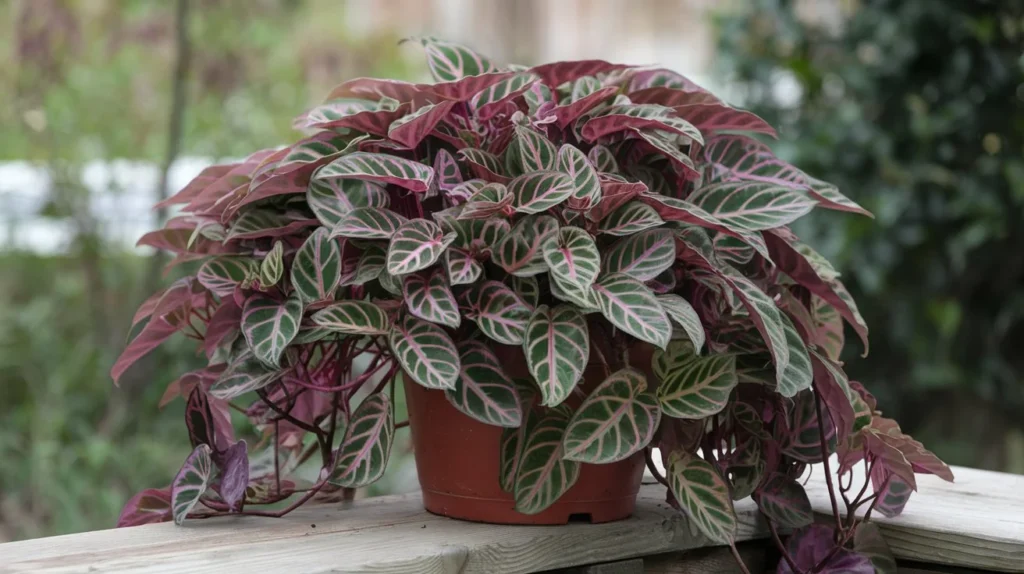Looking to brighten up your indoor space? The wandering jew plant is a great pick. It’s easy to care for and loved by many. Its beautiful leaves and vines add life to any room, perfect for beginners and experts alike.
This guide will cover everything you need to know about caring for your wandering jew plant. We’ll talk about its special needs and how to keep it happy. You’ll learn about light, water, and humidity to make your plant thrive.
Key Takeaways
- The wandering jew plant is a versatile and low-maintenance indoor plant with striking foliage and trailing vines.
- It thrives in a variety of indoor environments, making it a great choice for both novice and experienced plant owners.
- Proper light, watering, and humidity requirements are essential for the plant’s health and growth.
- With the right care, the wandering jew plant can bring a touch of natural beauty to your indoor spaces.
- This beginner’s guide provides comprehensive information to help you cultivate a thriving wandering jew plant in your home.
Understanding the Wandering Jew Plant
The wandering jew, also known as the spiderwort or inch plant, is a group of trailing vines. They belong to the Commelinaceae family. These plants are known for their vibrant foliage and easy care, making them great for indoor gardens and hanging baskets.
Different Varieties and Species
There are many species and varieties of the wandering jew plant. Each has its own unique features. Some common types include:
- Tradescantia zebrina (Wandering Jew) – Characterized by purple-and-green striped leaves
- Tradescantia pallida (Purple Heart) – Featuring deep purple foliage
- Tradescantia fluminensis (Small-Leaf Spiderwort) – Known for its small, green leaves
- Tradescantia sillamontana (White-Velvet Wandering Jew) – Boasts fuzzy, silver-green leaves
Natural Habitat and Growth Patterns
Wandering jew plants come from tropical and subtropical Americas, especially Mexico and Central America. In the wild, they grow as groundcover or vines in moist, shaded spots. Indoors, they grow as trailing vines, perfect for hanging baskets or containers.
Common Characteristics
Wandering jew plants have some key features. They have succulent, elongated leaves in green, purple, or variegated colors. Their stems are often purple or reddish. They also produce small, three-petaled flowers in pink, white, or purple.
These plants are easy to care for. They can grow well in many conditions and grow quickly.
| Variety | Leaf Color | Flower Color | Growth Habit |
|---|---|---|---|
| Tradescantia zebrina | Purple and green stripes | Pink | Trailing/Cascading |
| Tradescantia pallida | Deep purple | Purple | Trailing/Cascading |
| Tradescantia fluminensis | Green | White | Trailing/Cascading |
| Tradescantia sillamontana | Silver-green, fuzzy | Pink | Trailing/Cascading |
Essential Growing Requirements for Your Wandering Jew
Proper care is key for your wandering jew plant to do well. Whether you’re new to plants or have experience, knowing what your wandering jew needs is important. It helps you make the best home for it to grow.
Soil and Potting Needs
Wandering jews like soil that drains well and is full of nutrients. A mix made for succulents or cacti is best. It keeps the soil right for your plant to grow without getting too wet.
When you need to repot, pick a pot that’s just a bit bigger than the plant’s roots. This helps your plant grow without getting too crowded.
Watering and Humidity
- Water your wandering jew when the top inch of soil feels dry to the touch. Don’t let the soil get too wet or dry, as this can harm the roots.
- Keep the humidity around your plant moderate. You can mist the leaves or use a pebble tray to add moisture if your home is dry.
Temperature and Light Requirements
Wandering jews love warm, bright places but need protection from direct sunlight. This can burn their leaves. Keep the temperature between 65°F and 85°F. Make sure your plant gets at least 6 hours of bright, indirect light each day.
| Soil Type | Watering Needs | Temperature Range | Light Requirements |
|---|---|---|---|
| Well-draining, nutrient-rich | Water when top inch of soil is dry | 65°F – 85°F | 6+ hours of indirect, bright light |
By following these wandering jew care tips, you can make the best home for your how to care for a wandering jew plant. Watch it grow and thrive in your space.

Optimal Light Conditions and Placement
Getting the right light for your wandering jew plant is crucial for its health and growth. These plants need specific light conditions. You should think about this when picking a spot indoors.
Direct vs. Indirect Sunlight Needs
Wandering jew plants love bright, indirect sunlight. They can handle some direct sun, but too much can burn their leaves and slow growth. The best place for your plant is near a window that gets bright, indirect light. East- or north-facing windows are perfect.
Best Indoor Locations
- Bathrooms or kitchens: These humid spots are great for your wandering jew.
- Windowsills or shelves: Place your plant near a window but not in direct sun.
- Tabletops or plant stands: Raise your wandering jew to get enough light.
Signs of Improper Light Exposure
Watch for these signs that your wandering jew isn’t getting the right light:
- Stretched or leggy growth: Means the plant is looking for more light.
- Faded or discolored leaves: Too much direct sun can cause this.
- Drooping or wilting leaves: Not enough light might make the leaves sag.
Knowing what light your wandering jew needs and providing the right conditions will help it thrive. It will reward you with beautiful foliage and flowing growth.
Watering and Humidity Guidelines
Watering your wandering jew plant right is key for its growth. These plants like moist soil but not too wet. Before watering, verify that the top inch of soil has dried out.
Water until the soil is fully moist but don’t overdo it. Excess water can lead to root rot, which can damage your plant. Water once a week, but adjust based on your plant’s size and your home’s environment.
Keeping the humidity right is also important. Wandering jews do best in 40-60% humidity. If leaves curl or turn brown, the air might be too dry. Use a humidifier or mist the plant often to keep it happy.
FAQ
What is a wandering jew plant?
The wandering jew plant, also known as the wondering jew or inch plant, is a fast-growing, trailing houseplant. It has vibrant, striped foliage. It belongs to the Tradescantia genus and adapts well to indoor growing conditions.
What are the various types of wandering jew plants?
There are several varieties of wandering jew plants. Tradescantia zebrina is the most common. Others include Tradescantia pallida and Tradescantia fluminensis. Each variety has unique leaf patterns, colors, and growth habits.
Where do wandering jew plants naturally grow?
Wandering jew plants are native to tropical and subtropical Americas, especially Mexico and South America. They thrive in warm, humid environments. They grow as groundcover or trailing vines in their natural habitats.
What are the key characteristics of wandering jew plants that make it unique?
Wandering Jew plants are characterized by their cascading, fleshy stems and vibrant, striped foliage. Leaf colors vary from green and purple to silver and pink, depending on the variety. They also produce small, three-petaled flowers in white, pink, or purple.
How much light do wandering jew plants need?
Wandering jew plants prefer bright, indirect sunlight. They can handle some direct sun but intense sunlight can harm the leaves. Place your plant in a location with ample natural light, but keep it out of direct sunlight
How often should I water my wandering jew plant?
Wandering jew plants like consistently moist soil but don’t like to be waterlogged. Water the top layer of soil has dried out. Avoid letting the soil dry completely. Maintain the soil moisture consistently, but avoid overwatering.
What humidity level is ideal for a wandering jew plant?
Wandering jew plants thrive in humid environments. Aim for a humidity level of 40-60% around your plant. You can increase humidity by misting the leaves, using a pebble tray, or placing the plant in a bathroom or kitchen.




